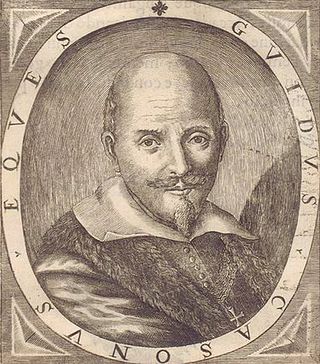History
The Accademia degli Oziosi was founded in 1611 by Giovanni Battista Manso, Marquis of Villa. The Academy was officially inaugurated on May 3, 1611 in the cloister of Santa Maria delle Grazie. It played a key role in introducing conceptismo to Naples, where orthodox Petrarchism had displaced the richly experimental poetry produced there in the previous decades. The Academy soon became one of the places for the formation of the Neapolitan intellectual elite. When Giambattista Marino returned to his native city in 1624, he was elected the Academy's Principe. After the death of Marino in 1625 Manso himself became Principe of the Oziosi, a position which he was to hold until his own death on 28 December 1645.
The Academy originally met in the cloister of Santa Maria delle Grazie e Sant'Agnello. From 1615 onwards the meetings were held at San Domenico Maggiore. The Oziosi numbered many notable men of letters, including Angelo Grillo, Giambattista della Porta and Giovanni Vincenzo Imperiale. Among its foreign members the Academy numbered the brothers Bartolomé and Lupercio Leonardo de Argensola. [4]
The Academy enjoyed patronage from the viceroy of Naples Pedro Fernández de Castro, Count of Lemos. In the early seventeenth century it was the most important cultural institution of the city outside the university. Manso introduced John Milton to the Accademia degli Oziosi in 1638. [5] By the mid 1650s the Academy became the launching platform for the literary careers of a long series of poets who moved conceptismo towards ever more elaborate and ornately erudite forms, most notably Giuseppe Battista.
The Academy became defunct around 1700. The laws of the Oziosi are preserved in a manuscript in the Biblioteca Nazionale Vittorio Emanuele III. [6]

The Gallerie dell'Accademia is a museum gallery of pre-19th-century art in Venice, northern Italy. It is housed in the Scuola della Carità on the south bank of the Grand Canal, within the sestiere of Dorsoduro. It was originally the gallery of the Accademia di Belle Arti di Venezia, the art academy of Venice, from which it became independent in 1879, and for which the Ponte dell'Accademia and the Accademia boat landing station for the vaporetto water bus are named. The two institutions remained in the same building until 2004, when the art school moved to the Ospedale degli Incurabili.

Vincenzo Cuoco was an Italian writer. He is mainly remembered for his Saggio Storico sulla Rivoluzione Napoletana del 1799. He is considered as one of the precursors of the realist school and Italian liberalism. Cuoco adapted the critique of political rationalism of Edmund Burke and Joseph de Maistre for liberal ends, and has been described as a better historian than either of them. He influenced many subsequent Italian intellectuals, from Ugo Foscolo and Alessandro Manzoni to Bertrando and Silvio Spaventa to Benedetto Croce and Antonio Gramsci.
Torquato Accetto was an Italian writer born in Trani. He is particularly remembered for his book on conformity and hypocrisy, titled Della dissimulazione onesta.

The Palazzo D'Afflitto is a palace located in the San Giuseppe neighbourhood of Naples, Italy, adjacent to the Palazzo Capomazza di Campolattaro. It used to belong to the princely family d'Afflitto. In the third floor is the recently restored Church of the Real Monte Manso di Scala, built atop the famed Cappella Sansevero. The palace was built in the 15th century but underwent numerous reconstructions.

The Accademia degli Umoristi founded in 1603 was a learned society of intellectuals, mainly noblemen, that significantly influenced the cultural life of 17th century Rome. It was briefly revived in the first half of the eighteenth century by Pope Clement XI.

Giuseppe Battista was a prolific Italian marinist poet and writer.
Annibale Giuseppe Nicolò Giordano was an Italian-French mathematician and revolutionary.
Giovanni Battista Manso was an Italian aristocrat, scholar, and patron of the arts and artists. He was for many years the leading figure in Neapolitan poetic and intellectual circles.
Antonio Bruni was an Italian Marinist poet. He was one of the most successful of Marino's followers.
Scipione Errico was an Italian poet, writer, literary critic and academic.

Girolamo Preti was an Italian Baroque poet. He is considered one of the most accomplished of early 17th-century poets.

The Accademia dei Gelati was a learned society of intellectuals, mainly noblemen, that significantly influenced the cultural and political life of Baroque Bologna. It is considered one of the most important 17th-century Italian academies.
Leonardo Quirini was an Italian nobleman and Marinist poet.

Guido Casoni was an Italian Baroque poet, jurist, and writer. He was a forerunner of Marinism, anticipating the tastes and values of the Baroque years before Seicentismo became the leading fashion in Italian literature.

Giovanni Vincenzo Imperiale was an Italian nobleman, art collector, and man of letters.
Gabriele Zinani was an Italian poet, playwright, and political theorist.

Giovan Battista Lalli was an Italian poet and jurist. He was the author of numerous mock-heroic poems among which La franceide and L'Eneide travestita are probably the best known.

Giovan Francesco Maia Materdona was an Italian Baroque poet and Roman Catholic priest.
Andrea Barbazza was an Italian Marinist poet and literary critic.
This page is based on this
Wikipedia article Text is available under the
CC BY-SA 4.0 license; additional terms may apply.
Images, videos and audio are available under their respective licenses.











